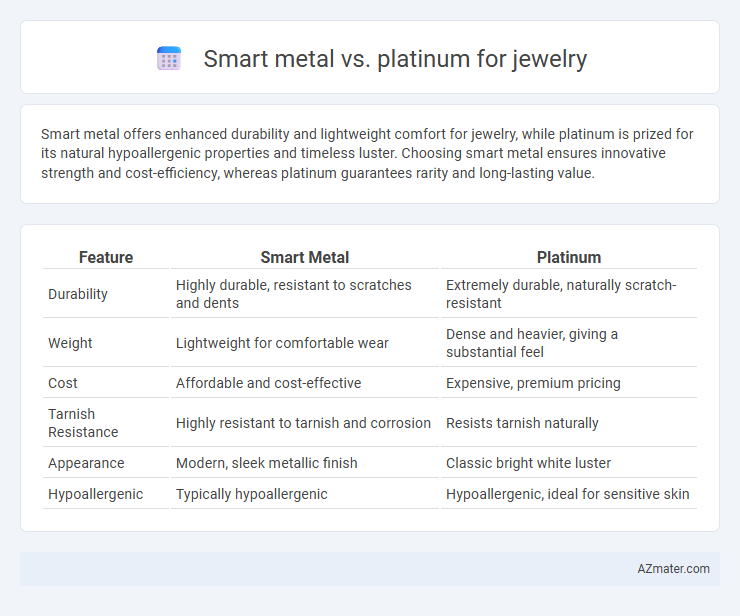Smart metal offers enhanced durability and lightweight comfort for jewelry, while platinum is prized for its natural hypoallergenic properties and timeless luster. Choosing smart metal ensures innovative strength and cost-efficiency, whereas platinum guarantees rarity and long-lasting value.
Table of Comparison
| Feature | Smart Metal | Platinum |
|---|---|---|
| Durability | Highly durable, resistant to scratches and dents | Extremely durable, naturally scratch-resistant |
| Weight | Lightweight for comfortable wear | Dense and heavier, giving a substantial feel |
| Cost | Affordable and cost-effective | Expensive, premium pricing |
| Tarnish Resistance | Highly resistant to tarnish and corrosion | Resists tarnish naturally |
| Appearance | Modern, sleek metallic finish | Classic bright white luster |
| Hypoallergenic | Typically hypoallergenic | Hypoallergenic, ideal for sensitive skin |
Introduction to Smart Metal and Platinum in Jewelry
Smart metal, often comprising titanium or memory metal alloys, offers jewelry that is lightweight, durable, and resistant to corrosion, making it ideal for everyday wear. Platinum, a precious metal known for its rarity, density, and natural white luster, is highly valued in luxury jewelry for its hypoallergenic properties and exceptional strength. Both materials provide distinct advantages: smart metal emphasizes innovation and practicality, while platinum embodies timeless elegance and prestige.
Chemical Composition and Properties Comparison
Smart metal alloys typically incorporate titanium, copper, and aluminum, offering excellent corrosion resistance, lightweight properties, and high tensile strength, making them ideal for durable jewelry. Platinum, a naturally occurring precious metal with a purity of 85-95% in jewelry (typically 950 platinum), is renowned for its exceptional density, hypoallergenic nature, and remarkable resistance to tarnish and wear. The chemical inertness of platinum contrasts with the engineered characteristics of smart metals, influencing factors such as maintenance, longevity, and suitability for sensitive skin.
Durability and Scratch Resistance
Smart metal alloys, such as titanium and tungsten carbide, offer exceptional durability and superior scratch resistance compared to platinum, making them ideal for everyday wear jewelry. Platinum, while highly durable and naturally resistant to tarnish, is softer and more prone to surface scratches over time. For jewelry that requires long-lasting resilience and minimal maintenance, smart metal compositions provide a more robust and scratch-resistant alternative to traditional platinum pieces.
Weight and Comfort on Skin
Smart metals like titanium and tungsten offer a lightweight alternative to platinum, significantly reducing finger fatigue for everyday wear. Their hypoallergenic properties enhance comfort, minimizing skin irritation often associated with heavier metals. Platinum's dense composition results in a heavier feel on the skin, but it provides unmatched durability and a luxurious, enduring finish.
Color, Luster, and Visual Appeal
Smart metals used in jewelry, such as white gold alloys or titanium blends, offer a modern, sleek color palette with a bright white or silvery tone that rivals platinum's naturally white hue. Platinum boasts unmatched luster due to its dense molecular structure, providing a high shine and lasting brilliance that resists tarnish and wear over time. While smart metals can be more affordable and lightweight, platinum's visual appeal lies in its rich, radiant finish and enduring elegance that many luxury jewelry connoisseurs prefer.
Hypoallergenic Qualities and Skin Reactions
Smart metal alloys, such as titanium and stainless steel, are highly favored in jewelry due to their excellent hypoallergenic qualities, causing minimal skin reactions even for sensitive individuals. Platinum is naturally hypoallergenic and highly resistant to tarnish and corrosion, making it a premium choice for those prone to allergies or skin irritation. Both metals' biocompatibility ensures safe, long-lasting wear without common metal-induced dermatitis or allergic flare-ups.
Maintenance and Care Requirements
Smart metal jewelry offers low maintenance with high resistance to scratches and tarnish, requiring only occasional cleaning with mild soap and water. Platinum, while highly durable and hypoallergenic, needs regular polishing to maintain its shine and may develop a patina over time that some wearers cherish. Both metals benefit from storing separately in soft pouches to prevent surface damage, but smart metals generally demand less frequent professional care.
Price Comparison and Long-Term Value
Smart metal offers an affordable alternative to platinum, with prices often significantly lower while maintaining durability and a sleek appearance. Platinum jewelry commands a premium price due to its rarity, hypoallergenic properties, and exceptional longevity, making it a valuable investment over time. When considering long-term value, platinum tends to retain or increase its worth, whereas smart metal provides cost-effective style but may not appreciate in value.
Sustainability and Environmental Impact
Smart metal, often composed of recycled materials and engineered for durability, offers a sustainable alternative to traditional platinum in jewelry due to its reduced mining footprint and lower carbon emissions. Platinum extraction involves intensive mining processes that contribute significantly to habitat disruption and greenhouse gas emissions. Choosing smart metals supports eco-friendly practices by minimizing waste and promoting recycling in the jewelry industry.
Popular Trends in Jewelry Design
Smart metal alloys in jewelry design are gaining popularity due to their enhanced durability, lightweight properties, and affordability compared to traditional platinum. Platinum maintains a timeless appeal with its natural luster, hypoallergenic qualities, and rarity, making it a symbol of luxury and permanence in high-end jewelry. Current trends highlight a shift towards smart metals for fashion-forward, everyday wear pieces while platinum remains favored for classic engagement rings and heirloom-quality items.

Infographic: Smart metal vs Platinum for Jewelry
 azmater.com
azmater.com